Resource:
SystemVerilog Assertion Fundamentals (English)
SystemVerilog Assertions (SVA), defined in IEEE 1800, provide a concise and formal mechanism to specify and verify the expected behavior of digital hardware. Built on a layered structure of boolean expressions, sequences, and properties, SVA enables temporal modeling of design behavior and facilitates automated checking through directive keywords such as assert, assume, and cover. These constructs allow formal and simulation-based tools to detect violations and capture functional coverage. The approach supports modular, reusable assertion writing and integration into both RTL and verification environments, enhancing observability and enabling specification-driven validation in hardware design workflows.
Purchase
Our course syllabus is regularly updated to reflect the latest advancements and best practices in the field. For individually purchased courses or resources with lifetime access, students can always access the content and receive updates for free. For members, all member-free courses and resources — including future updates — are accessible during the active subscription period. This ensures that both lifetime purchasers and active members can benefit from the most relevant and up-to-date content.
Created by EDA Academy
English
Last updated June 2025

Resource: SystemVerilog Assertion Fundamentals (English)
OR
USD $99.9
-60%Today
$39.9
One-time Purchase
& Lifetime Access
What you will get:
1.2 Hours of Immersive, High-Quality Video Lessons
Professionally produced and delivered by our expert team, covering core concepts and practical demonstrations, with step-by-step explanations and real-life examples to help you efficiently absorb knowledge and apply it immediately in a short time.
Certificate of completion
Upon successful completion of the course, you will receive an official certificate issued by EDA Academy, adding value to your resume and career development.
Access on mobile and computer
The course can be viewed anytime on mobile phones, tablets, and computers, allowing you to learn easily whether at the office, at home, or on the go.
Ongoing support from EDA Academy
After the course ends, you will continue to receive ongoing support from our team to help you consolidate knowledge and solve practical problems.
Further learning plan
Provides you with follow-up learning paths and recommended resources, enabling you to continue improving your skills and expanding your career development based on what you have learned.
Resource Catalogue
Description
SystemVerilog Assertions are a formal component of the SystemVerilog standard that enable the explicit specification of design intent. They are organized into a layered structure consisting of boolean expressions, sequences, and properties, each serving a distinct role in defining expected behaviors. Boolean expressions operate at a single simulation timestep, specifying conditions such as signal equality, inequality, or stability. These form the atomic conditions that sequences and properties use to describe more complex behavior across multiple cycles. The hierarchy allows for systematic abstraction and composition of design expectations, promoting clarity and scalability in assertion-based verification.
Sequences in SVA describe temporal relationships over time. They capture the ordering, timing, and repetition of events on signal transitions across multiple cycles. Operators such as ##, [*], and within provide fine-grained control over temporal resolution. Sequence constructs allow the specification of causal behaviors, such as “if signal A is high, then signal B must follow after two cycles.” These relationships are essential for modeling realistic timing constraints and for checking protocol conformance. Additional features like fusion and intersection operators allow combining sequence expressions for compact and expressive behavior modeling.
Properties bind sequences and boolean expressions to verification semantics. They serve as containers for behavior that should or should not occur, and they are annotated with directive keywords. assert is used to check that properties always hold, assume constrains the environment in formal analysis, and cover tracks whether certain behaviors have occurred. Strong and weak operators provide semantic flexibility, determining whether a property must always eventually hold (strong) or may hold if possible (weak). These constructs collectively support the formalization of design correctness, ensuring exhaustive checking in both simulation and formal engines.
The directive keywords in SVA control how and when properties are evaluated. They define the verification intent and drive tool behavior in various flows. Assertion placement is flexible; properties can be embedded directly into RTL modules, interfaces, or instantiated in verification checkers. Different placements provide different visibility and reuse benefits. Assertions in RTL modules gain tight coupling to signals but may be less portable. Interface-based assertions improve encapsulation, while checker modules support centralized verification. Proper selection of assertion placement enhances modularity, coverage observability, and debug traceability.
Effective use of SystemVerilog Assertions depends on adherence to consistent coding patterns and precise use of syntax. Maintaining readability and structural clarity in assertions is critical for maintainability and review. The SVA subset covered in practical design flows focuses on essential operators and constructs that provide the maximum benefit with minimal overhead. A disciplined approach to writing, organizing, and reviewing assertions ensures that they serve as enforceable rules that directly reflect the design specification. When properly deployed, assertions become integral to the verification methodology, enabling faster debug, improved coverage, and higher confidence in functional correctness.
We HATE spam. Your email address is 100% secure
The document will be emailed to you. Please check your Spam folder if it doesn’t appear in your inbox.
We HATE spam. Your email address is 100% secure
